The following is a list of currently active Punic Navy watercraft grouped by type of watercraft.
Aircraft carriers
Supercarriers
| Supercarriers
|
| Class
|
Image
|
Type
|
Origin
|
Displacement
|
Service
|
Quantity
|
Notes
|
| Leptis Magna
|

|
Supercarrier [CVAN]
|
 Carthage Carthage
|
116,500 tonnes
|
2010-present
|
24 active, 16 building, 100 ordered
|
Third-generation CATOBAR nuclear supercarrier with increased hangar space and reduced radar cross section, replacing all previous supercarrier classes in service.
|
| Hannibal Barca
|

|
Supercarrier [CVAN]
|
 Carthage Carthage
|
100,700 tonnes
|
1972-present
|
116 active, 24 retired
|
Second-generation CATOBAR nuclear supercarrier, to be retired in favor of the Leptis Magna-class.
|
Support carriers
| Light carriers
|
| Class
|
Image
|
Type
|
Origin
|
Displacement
|
Service
|
Quantity
|
Notes
|
| Diligence
|

|
Anti-submarine carrier [CVS]
|
 Japan Japan
|
68,000 tonnes
|
2006-present
|
40 active, 8 building, 48 ordered
|
Support CATOBAR carrier designed for sea control and anti-submarine warfare, supporting an air wing of up to 60 aircraft.
|
Amphibious warfare ships
Amphibious assault ships
| Amphibious assault ships
|
| Class
|
Image
|
Type
|
Origin
|
Displacement
|
Service
|
Quantity
|
Notes
|
| Panormus
|
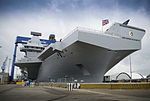
|
Amphibious assault ship [LHDN]
|
 Carthage Carthage
|
59,300 tonnes
|
2010-present
|
16 active, 4 building, 26 ordered
|
Second-generation nuclear amphibious assault ship, replacing the Syracuse-class. Designed with additional space to house and deliver two battalions of amphibious troops and equipment and provide additional air support over previous designs. Also includes a well deck capable of accommodating the large Reykjavik-class LCAC.
|
| Syracuse
|

|
Amphibious assault ship [LHD]
|
 Carthage Carthage
|
45,400 tonnes
|
1973-present
|
44 active
|
First-generation amphibious assault ship, in service but scheduled to be replaced by the Panormus-class. Designed with sufficient space for two battalions of amphibious troops while providing air support ashore.
|
Amphibious transport docks
| Amphibious transport docks
|
| Class
|
Image
|
Type
|
Origin
|
Displacement
|
Service
|
Quantity
|
Notes
|
| Lilybaeum
|

|
Landing platform dock [LPD]
|
 Carthage Carthage
|
31,150 tonnes
|
2006-present
|
24 active, 6 building, 40 ordered
|
Amphibious transport dock designed to land troops via landing craft and helicopters, and provide supplementary landing capability for amphibious groups alongside assault ships. Includes well deck support for the Reykjavik-class LCAC.
|
| Motya
|

|
Landing platform dock [LPD]
|
 Carthage Carthage
|
26,000 tonnes
|
1976-present
|
46 active
|
Previous-generation amphibious transport dock designed to land troops via landing craft and helicopters, and provide supplementary landing capability for amphibious groups alongside assault ships.
|
| Aokar Sephardis
|

|
Mobile landing platform [APL]
|
 Carthage Carthage
|
65,150 tonnes
|
2004-present
|
24 active, 2 building, 16 ordered
|
Mobile transfer platform designed to facilitate the movement of vehicles and cargo from transports to landing craft for delivery on or beyond the beach. Also incorporates helicopter facilities.
|
Landing craft
| Landing craft
|
| Class
|
Image
|
Type
|
Origin
|
Displacement
|
Service
|
Quantity
|
Notes
|
| Reykjavik
|

|
Landing craft [LCAC]
|
 Gensokyo Republic Gensokyo Republic
|
700 tonnes
|
2001-present
|
144 active
|
Heavy landing craft capable of ferrying a platoon of tanks or a company of infantry ashore. Equipped with a light missile and gun armament for self defense and support of landing operations. Due to their size, they are primarily operated from mobile landing platforms, rather than assault ships.
|
| Nuuk
|

|
Landing craft [LCAC]
|
 Inukirinwdene Inukirinwdene
|
220 tonnes
|
2006-present
|
320 active
|
Air-cushioned landing craft capable of transporting a single main battle tank or a platoon of infantry ashore. More commonly used aboard assault ships due to their more compact size, especially legacy ships with insufficient well deck space to accommodate the larger Reykjavik-class. Replaces the older Narsaq-class of similar dimensions, but with updated electronics and improved engines to handle higher payloads, including heavier up-armored battle tanks.
|
| Tanegashima
|

|
Landing craft [LCU]
|
 Japan Japan
|
1,200 tonnes
|
1990-present
|
180 active
|
Heavy landing craft used to ferry supplies, vehicles, and personnel ashore.
|
Surface combatants
Cruisers
| Cruisers
|
| Class
|
Image
|
Type
|
Origin
|
Displacement
|
Service
|
Quantity
|
Notes
|
| Karisimbi
|

|
Guided missile cruiser [CGN]
|
 Carthage Carthage
|
24,320 tonnes
|
2009-present
|
72 active, 12 building, 132 ordered
|
Third-generation nuclear guided missile cruiser, replacing the Sinai-class in service. Designed to provide and coordinate air defense for battle groups and fleets. The first Carthaginian warship class armed with anti-ship ballistic missiles.
|
| Sinai
|

|
Guided missile cruiser [CGN]
|
 Carthage Carthage
|
17,250 tonnes
|
1972-present
|
180 active, 64 retired
|
Second-generation nuclear guided missile cruiser, and the first Carthaginian cruiser class built with a vertical launch system. Unlike previous classes, the Sinai-class introduces nuclear propulsion for increased high-speed endurance to escort battle groups on long deployments. Being replaced by the Karisimbi-class.
|
| Zapote
|

|
Guided missile cruiser [CG]
|
 Carthage Carthage
|
9,100 tonnes
|
1968-present
|
44 active, 96 retired
|
First-generation guided missile cruiser, initially armed with rail launchers but now retrofitted with vertical launch systems. Originally planned to be retired in the early 1990s, 24 ships remain in service to cover the retirement of the earliest Sinai-class cruisers due for nuclear refueling. These will be replaced by newer Karisimbi-class cruisers.
|
Destroyers
| Destroyers
|
| Class
|
Image
|
Type
|
Origin
|
Displacement
|
Service
|
Quantity
|
Notes
|
| Johann A. Revil
|

|
Guided missile destroyer [DDGN]
|
 Carthage Carthage
|
13,800 tonnes
|
2009-present
|
96 active, 12 building, 190 ordered
|
Fourth-generation guided missile destroyer, originally slated to replace the Elementario-class in all roles but now reserved for carrier escort purposes. The Johann A. Revil-class introduces nuclear propulsion for destroyers to improve endurance for long-range deployments.
|
| Elementario
|

|
Guided missile destroyer [DDG]
|
 Carthage Carthage
 Japan Japan
|
11,800 tonnes
|
1989-present
|
650 active, 20 building, 80 ordered
|
Third-generation guided missile destroyer. Originally slated to be replaced by the nuclear Johann A. Revil-class, due to rising costs the Johann A. Revil-class was reserved for carrier escort roles and additional Elementario-class ships were ordered, incorporating an improved electronics suite developed for the Revil-class.
|
| Ballista
|
|
Multi-mission surface combatant [DDMN]
|
 Carthage Carthage
|
11,150 tonnes
|
2009-present
|
40 active, 4 building, 12 ordered
|
Multipurpose ship with a large mission flexible space, built on the hull of the Johann A. Revil-class destroyer. Incorporates a larger helicopter hangar, improved boat handling facilities, and a stern ramp for vehicles, with a reduced armament. The Ballista-class can deploy and support a company of tanks or infantry, or be fitted with other equipment including a larger towed array sonar or cargo for humanitarian missions.
|
Frigates
| Frigates
|
| Class
|
Image
|
Type
|
Origin
|
Displacement
|
Service
|
Quantity
|
Notes
|
| Orca-class
|

|
Guided missile frigate [FFG]
|
 Carthage Carthage
|
6,800 tonnes
|
2007-present
|
330 active, 40 building, 850 ordered
|
Guided missile frigate intended to replace the Otter-class, with improved multi-mission capability.
|
| Otter-class
|
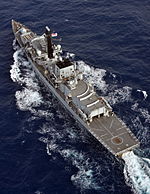
|
Guided missile frigate [FFG]
|
 Carthage Carthage
|
5,000 tonnes
|
1985-present
|
1,120 active, 160 retired
|
Anti-submarine frigate designed for patrol and support of carrier task forces. Currently being retired and replaced by the Orca-class.
|
Corvettes
| Corvettes
|
| Class
|
Image
|
Type
|
Origin
|
Displacement
|
Service
|
Quantity
|
Notes
|
| Dubhe-class
|

|
Corvette [PF]
|
 Carthage Carthage
|
3,950 tonnes
|
2008-present
|
56 active, 8 building, 116 ordered
|
Anti-submarine patrol ship designed to replace the Mizar-class corvette.
|
| Mizar-class
|

|
Corvette [PF]
|
 Carthage Carthage
|
2,200 tonnes
|
1985-present
|
229 active, 116 retired
|
Anti-submarine warship designed for coastal patrol and use in the Mediterranean and other protected seas.
|
Submarines
Attack submarines
| Attack submarines
|
| Class
|
Image
|
Type
|
Origin
|
Displacement
|
Service
|
Quantity
|
Notes
|
| Type-061N
|

|
Nuclear attack submarine [SSN]
|
 Carthage Carthage
|
9,500 tonnes
|
2011-present
|
66 active, 32 building, 382 ordered
|
Advanced nuclear attack submarine planned to replace Type-046N, Type-046N Advanced, and Type-054N in service.
|
| Type-046N Advanced
|

|
Nuclear attack submarine [SSN]
|
 Carthage Carthage
|
7,400 tonnes
|
1996-present
|
180 active
|
Improved variant of the Type-046N, incorporating technologies from the Type-054N into the existing Type-046N design. Estimated to be ten times quieter than legacy Type-046N boats, with longer endurance and additional VLS tubes. Planned to be replaced by Type-061N and possible successor designs.
|
| Type-054N
|

|
Nuclear attack submarine [SSN]
|
 Carthage Carthage
 Inukirinwdene Inukirinwdene
|
10,500 tonnes
|
1990-present
|
48 active
|
Nuclear attack submarine designed in cooperation with Inukirinwdene. Significantly larger and more capable than the Type-046N, the class was cancelled after 48 boats due to cost.
|
| Type-046N
|

|
Nuclear attack submarine [SSN]
|
 Carthage Carthage
|
7,250 tonnes
|
1972-present
|
196 active, 68 retired
|
Nuclear attack submarine that formed the backbone of the nuclear submarine force. The Type-046N was the first class in Carthaginian service to introduce VLS tubes. Currently being decommissioned, replaced by the Type-061N.
|
| Type-060
|
|
Diesel-electric submarine [SS]
|
 Carthage Carthage
|
4,000 tonnes
|
2010-present
|
80 active, 20 building, 220 ordered
|
Diesel-electric attack submarine designed for littoral defense and sea lane patrol. Also equipped with vertical launch tubes for land attack and anti-ship missile deployment. Planned to replace Type-035 in service.
|
| Type-035
|
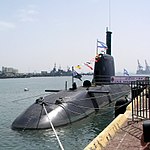
|
Diesel-electric submarine [SS]
|
 Carthage Carthage
|
2,720 tonnes
|
1974-present
|
320 active, 60 retired
|
Diesel-electric attack submarine designed primarily for littoral defense but also incorporating vertical launch tubes for increased flexibility and firepower over previous designs.
|
Ballistic missile submarines
| Ballistic missile submarines
|
| Class
|
Image
|
Type
|
Origin
|
Displacement
|
Service
|
Quantity
|
Notes
|
| Type-062N
|

|
Nuclear ballistic missile submarine [SSBN]
|
 Carthage Carthage
|
20,200 tonnes
|
2012-present
|
14 active, 8 building, 122 ordered
|
New nuclear ballistic missile submarine class developed in conjunction with the Type-060 and Type-061N, armed with 24 Astarte-III SLBMs. Projected to replace all current Type-053N SSBNs to maintain strategic deterrence through the 2070s.
|
| Type-053N
|

|
Nuclear ballistic missile submarine [SSBN]
|
 Carthage Carthage
|
19,000 tonnes
|
1974-present
|
131 active, 13 retired
|
Nuclear ballistic missile submarine armed with 24 Astarte-II missiles, later replaced by the modern Astarte-III. Previous submarine classes carried 16 tubes, allowing the Type-053N to replace older designs on a 2-for-3 basis, offsetting the design's higher cost. Replacement by the Type-062N is expected by 2040, due to reactor life constraints.
|
Mine warfare
| Mine countermeasures vessels
|
| Class
|
Image
|
Type
|
Origin
|
Displacement
|
Service
|
Quantity
|
Notes
|
| Sherpa
|

|
Mine countermeasures vessel [MCM]
|
 Carthage Carthage
|
1,300 tonnes
|
1995-present
|
88 active
|
Surface effect mine countermeasures vessel designed for rapid deployment and sweeping of minefields.
|
Unmanned vehicles
Light craft
| Light craft
|
| Class
|
Image
|
Type
|
Origin
|
Displacement
|
Service
|
Quantity
|
Notes
|
| Giza
|

|
Unmanned surface vessel [USV]
|
 Carthage Carthage
|
8 tonnes
|
2012-present
|
48 active, 202 on order
|
High-speed light unmanned craft designed for force protection, minesweeping, ASW, and other roles in conjunction with larger platforms or for harbor patrol.
|
Ocean escorts
| Ocean escorts
|
| Class
|
Image
|
Type
|
Origin
|
Displacement
|
Service
|
Quantity
|
Notes
|
| Artemis
|
<imgur w="150">wARH4S9.png</imgur>
|
Unmanned patrol vessel [UPV]
|
 Carthage Carthage
|
300 tonnes
|
2008-present
|
200 active, 8 building, 48 ordered
|
Ocean escort designed for autonomous anti-submarine patrols, equipped with a towed array sonar and MMEPS-C mounts for self-defense against surface and air threats.
|
| Rhodes
|
<imgur w="150">qFno4QX.png</imgur>
|
Unmanned patrol vessel [UPV]
|
 Carthage Carthage
|
440 tonnes
|
2011-present
|
112 active, 4 building, 36 ordered
|
Larger variant of the Artemis-class designed for extended patrol with additional fuel storage.
|
| Babylon
|
|
Ocean escort [UPV]
|
 Carthage Carthage
|
650 tonnes
|
2011-present
|
140 active
|
Higher-speed patrol vessel with supplementary gas turbine propulsion to operate in conjunction with battlegroups and improve fleet protection.
|
Special warfare
Surface craft
| Surface craft
|
| Class
|
Image
|
Type
|
Origin
|
Displacement
|
Service
|
Quantity
|
Notes
|
| Type-022
|

|
Light raiding craft
|
 Inukirinwdene Inukirinwdene
|
146 kg
|
1985-present
|
~1,200 active
|
Standard rigid-hulled inflatable boat utilized by special forces teams. Holds a maximum of eight personnel plus limited cargo and can be rapidly deployed from ships and helicopters. Often carried and deployed for support uses by warships as a general purpose inflatable boat.
|
| Type-024
|

|
Riverine patrol craft
|
 Japan Japan
|
17,000 kg
|
1997-present
|
168 active
|
Aluminum-hulled patrol and raiding craft designed for operation in rivers and other shallow draft areas. Operated by four crewmen with space for an additional eight personnel.
|
| Type-025
|
<imgur w="150">gcmOiMN.jpg</imgur>
|
Patrol craft
|
 Carthage Carthage
|
72,000 kg
|
2012-present
|
164 active
|
Compact marine security, patrol, and transportation boat used for roles ranging from harbor inspection to special forces insertion and extraction. Replaced the Type-023 beginning in 2012.
|
| Type-026
|

|
Delivery craft
|
 Carthage Carthage
|
65,000 kg
|
2013-present
|
4 active
|
Experimental pentamaran designed for special forces support and delivery. Can deliver up to 12 personnel plus RHIBs, UAVs, and other support equipment.
|
| Type-027
|
<imgur w="150">HNLmlEu.jpg</imgur>
|
Littoral combat ship [LCS]
|
 Japan Japan
|
200 tonnes
|
2014-present
|
4 active, 2 building, 18 ordered
|
Fast littoral combat ship designed to deploy and support special forces teams and provide coastal patrol and interdiction capabilities. While possessing anti-ship combat abilities, the class is considered a surface delivery vehicle and is operated by personnel from the Special Warfare Support Division.
|
Swimmer delivery vehicles
| Swimmer delivery vehicles
|
| Class
|
Image
|
Type
|
Origin
|
Displacement
|
Service
|
Quantity
|
Notes
|
| Type-019
|

|
Swimmer delivery vehicle [SDV]
|
 Carthage Carthage
|
55 tonnes
|
1995-present
|
24 active
|
Miniature submarine designed to covertly deploy and recover special forces teams, with greater range and protection than the open Type-015.
|
| Type-015
|

|
Swimmer delivery vehicle [SDV]
|
 Inukirinwdene Inukirinwdene
|
10 tonnes
|
1989-present
|
104 active
|
Compact submersible designed to deliver special forces teams and their equipment.
|
Auxiliaries
Replenishment ships
| Replenishment ships
|
| Class
|
Image
|
Type
|
Origin
|
Displacement
|
Service
|
Quantity
|
Notes
|
| Nile
|

|
Fast combat support ship [AORN]
|
 Carthage Carthage
|
65,200 tonnes
|
2007-present
|
36 active, 4 building, 12 ordered
|
Fast replenishment ship designed to accompany and support task forces on extended deployments. Unlike previous classes, the Nile-class uses nuclear propulsion to allow high sustained transit speeds to and from deployment theaters.
|
| Congo
|

|
Fast combat support ship [AOR]
|
 Carthage Carthage
|
52,300 tonnes
|
2009-present
|
12 active, 2 building, 12 ordered
|
Fast replenishment ship designed to supplement the Nile-class in support of reserve task forces. Based on the Nile-class hull, the Congo-class uses conventional diesel propulsion for lower operating costs and an easier transition from reserve to active service as required.
|
| Zeus
|

|
USV tender [AUS]
|
 Carthage Carthage
|
58,100 tonnes
|
2010-present
|
24 active
|
USV support ship designed to repair, refuel, and maintain large unmanned surface vessels on deployment. Also designed to serve as a control ship for fleets of smaller unmanned vehicles. Built on the same hull as the Nile-class, but equipped with a well deck for internal servicing of USVs.
|
Transports
| Transports
|
| Class
|
Image
|
Type
|
Origin
|
Displacement
|
Service
|
Quantity
|
Notes
|
| William Michaelson
|
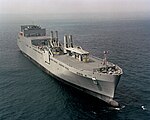
|
Vehicle cargo ship [AKR]
|
 Carthage Carthage
|
69,500 tonnes
|
2002-present
|
80 active
|
RORO vehicle cargo ship designed to carry vehicles and cargo to support troops ashore. Maximum capacity of up to 72 main battle tanks plus 60 other tracked vehicles and up to 1,000 trucks or wheeled vehicles with a maximum speed of 24 knots. Replaces the older 21-knot Ulysses S. Grant-class.
|
| Starstreak
|

|
High-speed support vessel [AFV]
|
 Carthage Carthage
|
1,600 tonnes
|
2008-present
|
48 active, 4 building, 16 ordered
|
SWATH multi-mission vessel designed to rapidly deliver moderate quantities of cargo within a region or between fleets. The class has a maximum capacity of over 300 personnel plus 550 tonnes of cargo and can travel at speeds of up to 43 knots. Also capable of accepting mission modules for basic combat capability and sea patrol, or for use as a basic hospital ship or amphibious warfare platform.
|
| Abirami Levine
|
<imgur w="150">QxmsoEq.jpg</imgur>
|
Dry cargo carrier [AK]
|
 Carthage Carthage
|
50,500 tonnes
|
1987-present
|
44 active
|
Combined container and RORO cargo carrier designed to provide ongoing logistical support for stations and operations abroad.
|
| Adisa Williams
|
<imgur w="150">XaR1XKU.jpg</imgur>
|
Petroleum tanker [AOT]
|
 Carthage Carthage
|
50,750 tonnes
|
1995-present
|
20 active
|
Medium-displacement tanker designed to supply petroleum products to Defense Forces operations abroad. The class replaces the older Diego Abarca-class and improves protection against spills by using a Coulombi Egg design. Adisa Williams-class tankers are designed to offload fuel at port facilities and are not equipped to provide underway replenishment.
|
Electronic warfare and surveillance
| Electronic warfare and surveillance
|
| Class
|
Image
|
Type
|
Origin
|
Displacement
|
Service
|
Quantity
|
Notes
|
| Tesla
|

|
Electronic warfare ship [AES]
|
 Carthage Carthage
|
15,200 tonnes
|
2008-present
|
18 active, 4 building, 36 ordered
|
Electronic countermeasures vessel equipped with radar and radio jammers as well as listening equipment for SIGINT/ELINT operations.
|
| Hanno the Navigator
|

|
Ocean survey ship [AGS]
|
 Carthage Carthage
|
5,200 tonnes
|
1995-present
|
12 active
|
Survey ship designed for acoustic, biological, geophysical, and hydrological research including the development of accurate seafloor maps in areas of interest.
|
| James Stowe
|
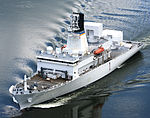
|
Tracking ship [AGM]
|
 Carthage Carthage
|
13,000 tonnes
|
2006-present
|
4 active
|
Missile range instrumentation ship.
|
Miscellaneous
| Miscellaneous
|
| Class
|
Image
|
Type
|
Origin
|
Displacement
|
Service
|
Quantity
|
Notes
|
| Repair
|

|
Salvage and recovery ship [ARS]
|
 Carthage Carthage
|
4,200 tonnes
|
1989-present
|
4 active
|
Salvage and recovery ships designed to assist damaged or stranded vessels, including support for diver operations, open-ocean towing, the lifting of downed components equipment, and firefighting.
|
| Republic Industry
|

|
Crane ship [ACS]
|
 Carthage Carthage
|
13,200 tonnes
|
1992-present
|
12 in reserve
|
Crane ship designed to support port operations in areas with insufficient infrastructure. Held in reserve during peacetime.
|




































